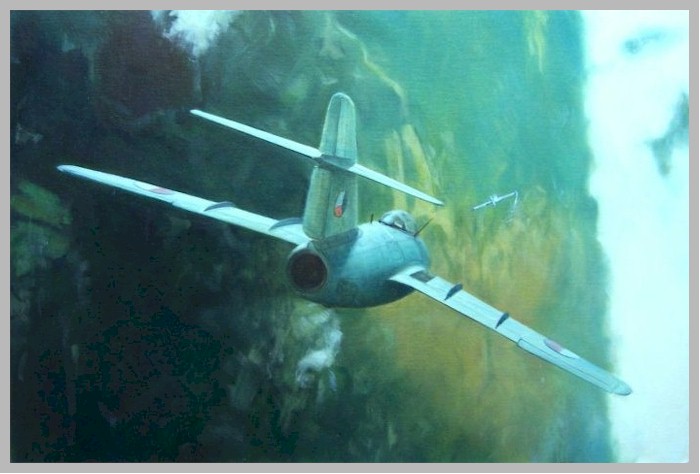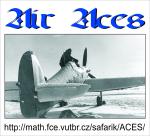|
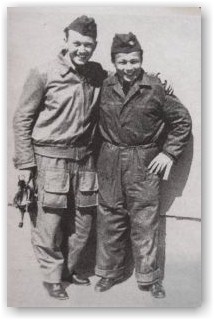 MiG-15 (S-102) vs F-84 Thunderjet, March 1953 MiG-15 (S-102) vs F-84 Thunderjet, March 1953
At the beginning of the 50s, at the outset of the Cold War era, Czechoslovak aviation was undergoing a period of enormous expansion, connected with the necessity to strengthen the air defense of our country to an adequate level. The relations between the East and the West at that time were severely strained. The war in Korea was in full swing, a third World War seemed a real threat.
In the absence of suitable technical equipment, which considerably lagged behind the parameters of military aircraft of that time, violations of air space along our western border were relatively frequent. In March 1953, one such violation by USAF fighters resulted in the shooting down of one American warplane F-84 Thunderjet. This remarkable event still arouses a well-deserved interest of historians of aviation as well as of the general public.
Official information from contemporary press:
Prague, 11 March (CTK – Czech Press Agency): On March 11, 1953, The Ministry of Foreign Affairs sent the following note to the American ambassador:
On the order of the Government, the Ministry of Foreign Affairs expresses its resolute protest in connection with a gross violation of the Czechoslovak air defense area by American military aircraft, on March 10, 1953.
On March 10, two American F-84 jet fighters entered Czechoslovak territory, where, at 11.05, 18 km southwest of Pilsen, 40 km from the state border, they encountered two patrolling Czech aircraft. The American planes were invited to land; they, however, ignored this invitation. During the subsequent air fight, one of the American airplanes took flight westwards; the other one was hit, caught fire and, sinking steadily, disappeared in the southwest.
Suddeutsche Zeitung, March 12:
„The American ambassador to Prague, Mr. Wadsworth, delivered, within 24 hours from the incident, a resolute protest note to the Czechoslovak Ministry of Foreign Affairs in connection with the incident in question. According to the report by the main European USAF Command in Wiesbaden, the incident occurred on Tuesday morning, at approximately 11 o’clock over the Hundessen farm near Falkenstein in the district of Roding, approximately 25 km from the Czech-German border. Two American F-84 jet fighters were making a routine flight at the altitude of 4000 meters, when two jets, probably Mig-15s, suddenly appeared from the Czechoslovak Republic and immediately opened fire at the American warplanes. While the pilot of the airplane which had been hit ejected and saved his life, the other American plane, without returning the fire, went back to the airport at Furstenfelbruck. Both pilots than said that they had not returned the fire although they had enough ammunition to do so.” According to the report, both pilots were absolutely sure that when the incident occurred they were flying over the German territory. Following that report, the American Secretary of State Dulles and the High Commissioner Conant qualified the incident as very serious, according to the Congressmen it was even the most serious incident ever since the beginning of the Cold War.
Detailed account of events – extract from the report by Gp.Capt. Štangl, Commander of 3rd Air force Division:
On March 1953, starting at 10:45, two pilots, Pilot Officer Jaroslav Šrámek and Pilot Officer Milan Forst of the 2nd flight of the 5th airforce regiment from the Plzeň – Líně airport were exercising type assaults. At 10.59, during the third flight in the direction of Přeštice-Holýšov, over the village of Merklín, the leading airplane spotted two aircraft, approaching from the left, at approximately 1000 meters below their altitude, at a distance of approx. 5 km. On approaching them more closely, Pilot Office Šrámek identified them as American F-84 jet aircraft Thunderjet. He reported the situation to the ground commander, Maj. Grznár, who was on duty on that day. P.O Šrámek then ordered the other pilot to end the training activity and to adopt the combat configuration. In the meantime, the intruders had probably noticed them and despite their inconvenient position at a lower altitude, immediately started a defense maneuver – the leading plane a sharp bend to the left, the guidee to the right.
Pilot Office Šrámek, covered by P.O. Forst, started to pursue the leading intruder, when, while making the first bend he obtained the order to attack and to fire a warning shot. The use of warning illuminating shells in accordance with the regulations, was already out of question. It was the intruders who started the fighting; to try and overtake them and fire the warning shells was no longer possible and might eventually have involved a risk for the pursuers themselves.
A warning shot, fired in the second bend, hit the fuel tank on the right wing of the Thunderjet, causing the fuel to leak rapidly. The intruder attempted to escape behind the state frontier, heading straight to the south at the maximum speed. However, he did not stand much chance against the faster „102s“. At 11.04, at the altitude of 2000 m, flying at a speed of 950 km/h P.O. Šrámek fired a second shot from the distance of 200-300 meters. These shots hit the fuselage of the Thunderjet. Out of its upper part behind the cockpit smoke came out, soon followed by flames. The burning aircraft continued to descend towards the state border, which was already near. That is why P.O. Šrámek ended the shooting, made an ascending bend left and announced the completion of the task. At the same time, however, the other F-84 aircraft suddenly flew over P.O. Forst’s plane, who immediately started to pursue the F-84, but soon lost it in clouds. At 11.06, when the configuration had been restored, the two pilots continued flying on the course of 320* to return back to their air-base. During the fight, they had lost orientation, and so after carrying out three locations between 11.11 and 11.14 they set the course at 062* and at 11.20 landed at Líně airport.
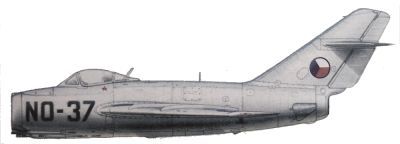
Analyses of the events:
Up to the present, debate is going on whether the American warplane was shot down while it was still flying over the Czechoslovak territory or whether it already found itself in the German airspace. Ing. Miroslav Irra from the Military Aviation History Society in his study, published in L+K magazine in 1999 concluded, on the basis of available sources, that the first stage of the fight, consisting in horizontal circles, probably took place over the Czech territory, while the second “deadly” shot was, in all probability, already fired on the German territory, in Bavaria, approximately 12 km beyond the state border.
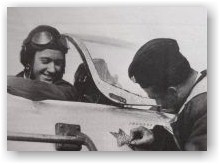
Selling information:
Print edition:
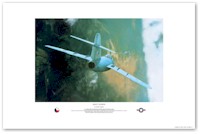
size 90x60 cm (35,4´ x 23,6´), matting chalk museum paper, 300 GSM
- edition PILOT (40 items, sidned by author and pilot of MiG-15 Jaroslav Sramek) ... price 50 EUR
REMARQUES
You can make Your print special and unique in any edition by additional pencil drawing
- price of edition + 20 EUR
Featured - pilots signature + 2 remarques ... price 80 EUR
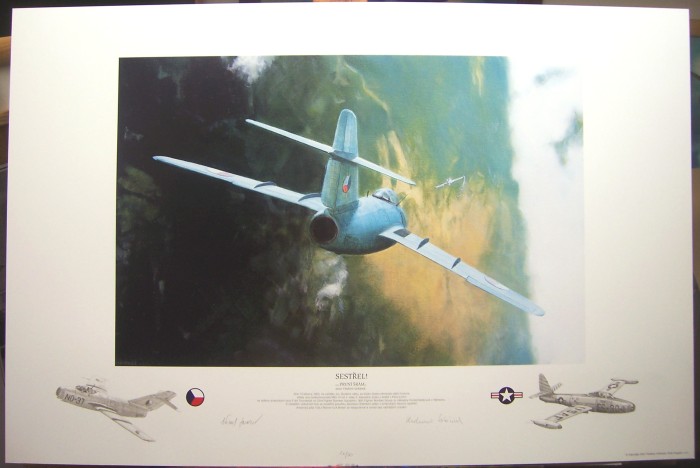
PAYMENT is supported by:
PAYPAL, Western Union, Eurogiro, wireless bank transfer, money order check, cash |
